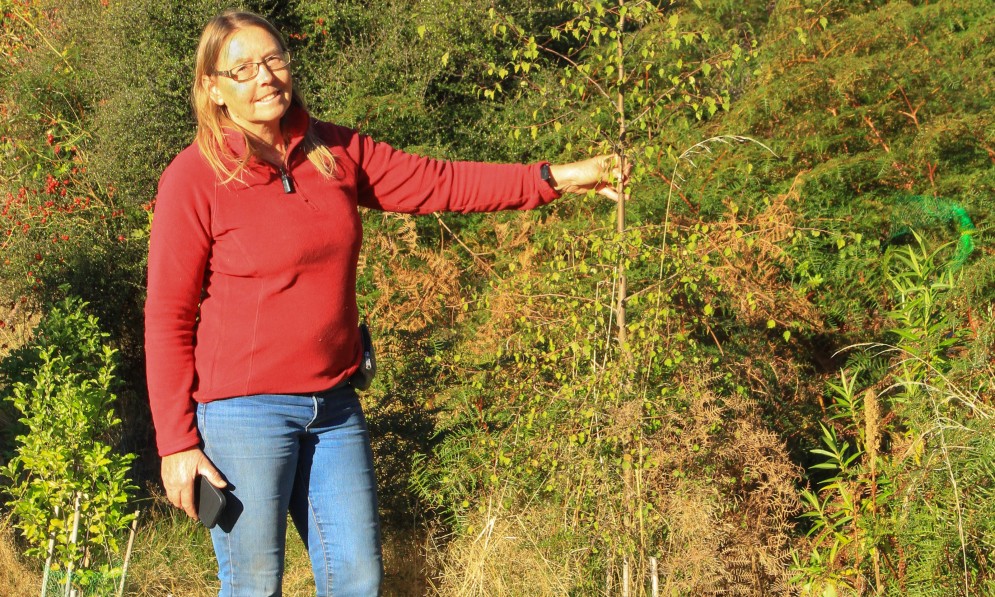For nearly 25 years, volunteers from Forest & Bird’s Central Otago-Lakes Branch have been looking after an important population of mohua in the ancient beech forests of Makarora.
Clearing the traps once a month – or once a fortnight during rat and stoat plagues – means members have to drive from the Wanaka-Hāwea area to Makarora, a round trip of up to 150km.
Forest & Bird magazine
A version of this story was first published in the Winter 2022 issue of Forest & Bird magazine.

The branch’s volunteers wanted to do something about the long-term climate impact of their car travel – emissions are currently estimated at seven tonnes of CO2 per annum.
They decided to create their own permanent forest “carbon sink” to offset the branch’s emissions, in partnership with high country farmers Geoff Ross and Justine Troy, the owners of Lake Hāwea Station.
Over the past three years, branch volunteers have planted hundreds of native trees on 2ha of station land known as Grandview Creek. The long-term aim is for Central Otago-Lakes to become Forest & Bird’s first certified carbon-neutral branch.
The plantings are within a wider area of the station protected by a Reserves Act covenant, and the carbon sequestration scheme is documented in a Memorandum of Understanding between Lake Hāwea Station and Central Otago-Lakes Branch.
In time, this new permanent native forest, located next to the Department of Conservation’s Grandview Mountain Track, will sequester all of the branch’s CO2emissions.
The branch initially thought about buying carbon credits from a reputable third-party scheme, but that would have involved someone else doing the work.

Mo Turnbull. Image Samuel Blanc
“We did some research and realised we could do it ourselves,” says Mo Turnbull, a retired geologist and and branch member, who helped establish the project in 2019, along with committee members Anne Steven, Evan Alty, and former chair Ben Goddard.
“We went through the process of working out our emissions, by accounting for all our driving in kilometres, totalling the fuel consumption, and converting that into tonnes of CO2.
“We are now into our third year of planting and record every tree that goes into the ground in Trees That Count.

This photographic monitoring point will show how the newly planted carbon forest on Lake Hāwea Station at Grandview Creek changes over the next few decades. Image Mo Turnbull
“Of course, like most branches, we plant trees in many other places as well, but this project is specifically aimed at carbon offsetting – with biodiversity enhancement and visual amenity as co-benefits.”
Geoff Ross says he was delighted to be able to help the branch.
"Mo contacted us out of the blue, and we thought it was a brilliant idea,” he said.
“The land we gave them was regenerating bush. It was scrubby and full of noxious weeds, so to get some help with it was wonderful.”
Species planted alongside the existing kānuka include mataī, tōtara, pittosporum, tī kouka cabbage trees, olearia tree daisies, lancewood, ribbonwood, kōwhai and beech.
All have been eco-sourced from local seeds grown by Te Kakano Aotearoa Trust and Matukituki Natives.
Arne Cleland, of Pukerau native plant nursery, former DOC staffer Geoff Rogers, and Wanaka landscape architect Anne Steven advised on the species selection and planting design.

Marjorie and Evan Alty at Grandview. Image Mo Turnbull
“Once the branch’s emissions are covered, Lake Hāwea Station will use the surplus carbon for their own carbon neutrality programme,” explains former Chair Evan Alty.
“The owners are great people to work with and are very active in conservation work. We will likely end up helping Lake Hāwea Station with their trapping programme in the future.”
Anne, Mo, and Evan hope Central Otago-Lakes Branch’s experience will inspire other branches to start tracking their own emissions.
“A lot of Forest & Bird branches are planting around the country. All they need to do is go through the same carbon accounting process. Everyone could do it,” adds Mo.
“We’d be delighted to share our experiences with other branches, so if people want to come and talk to us we’d be happy to help.”
It will take up to 50 years before the forest is mature enough to offset all the branch’s emissions, but our Central Otago-Lakes Branch volunteers are pleased to have made a start.
Thanks to this project, the branch is on its way towards becoming carbon positive – for the benefit of the climate, its local community, and nature.

Anne Steven with one of the new plantings. Image Mo Turnbull
Forest & Bird is keen to support other branches to monitor the climate impacts of their activities. National Office will be developing advice about suitable carbon calculators for branches, Youth Hubs, and KCC to use. If you would like to contact Central Lakes-Otago Branch, email editor@forestandbird.org.nz

Protecting Mohua
It’s hard work setting and clearing traps in the remote and rugged forest at Makarora, north of Wanaka. But the dedicated volunteers of Forest & Bird’s Central Otago-Lakes Branch are more than up for the challenge.
The branch has been looking after the beautiful yellow-headed mohua in these forests for more than a quarter of a century. It has steadily expanded its trapping network over the last few years and now operates 730 rat, stoat, and possum traps on 15 lines and two 100m grids.
About 45 volunteers are currently on the roster to clear the traps. There are only a few hundred mohua left in the project area, but recent surveys suggest they are holding on, thanks to the trapping and DOC’s 1080 campaigns. Two volunteers have electric cars, and one has made her EV available for other trappers to use.
But the project’s overall emissions were still considered too high, leading to the innovative idea of creating the branch’s own carbon-offset forest.

